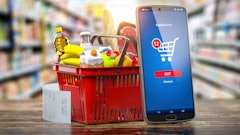
The Coronavirus disease (COVID-19) pandemic has brought turmoil to the grocery retail sector, as more and more consumers overcome a previous reluctance to order their groceries online. But, we’re not just talking about a spike in home deliveries or click-and-collect orders. As grocery chains are being forced to adopt new business models, the impacts are being felt further back in the supply chain, particularly in the delivery operations of the manufacturers and distributors who supply them.
As food retailers present their suppliers with rapidly and constantly changing distribution demands, the danger is that delivery costs will balloon and service levels will plummet, leading to uncertain supplies and more empty shelves. Without smart technology such as delivery route optimization solutions, delivery operations that replenish stores and distribution centers could become the Achilles heel of the industry.
Suddenly online
According to McKinsey, it’s not just a reluctance of consumers to buy meat, produce and other items online that has put the U.S. grocery sector behind the 8-ball when it comes to e-commerce. Another factor is that grocers have lacked the financial capacity to invest in the highly efficient, large-scale cold chains required to make home deliveries at a profit. Now, the COVID-19 pandemic has massively accelerated the adoption of ecommerce in grocery along with every other vertical. The question then becomes: if you’re fulfilling more orders online, how does that impact the way you receive, position and manage inbound inventory? This will have a profound effect deep in the supply chain as manufacturers and distributors serving grocery retailers adapt.
A new world of grocery retail replenishment
Suppliers are along for the ride when it comes to grocery retailers embarking on a wide-scale rethink in how the mix of online and in-person orders are handled. For example, one idea gaining traction in Europe is a micro-fulfillment center that combines a front-of-house retail area where consumers can pick produce and other perishables in person, while the more fungible items they’re willing to order online are picked and packed via automation in a small e-commerce fulfillment center behind a wall at the same establishment. The orders can then be combined at checkout (or gathered for home delivery). Additionally, there may be a move towards huge, centralized ecommerce fulfillment centers, such as those in existence for other consumer goods ordered online, geared to cut out the retail location altogether and deliver direct to consumers.
Businesses that deliver to food retailers will need to flex accordingly. Those who only deliver wholesale orders may even find themselves in the home delivery business. Certainly, there will be changes to delivery locations, as well as the size and variety of orders, with sustained and unpredictable volatility. Sophisticated routing software will be required to constantly spin up different delivery scenarios, while making sure costs don’t balloon out of control. The technology not only ensures the highest efficiency in day-to-day fleet operations, it also allows the user to model possible operational solutions for what customers are likely to do next.
Food distributors may need to constantly reconsider whether they have the right capacity and mix of vehicles, along with the drivers to operate them, which the software ensures. It also empowers users to easily share delivery data with other departments and their retail food customers, in order to inform strategic decisions and manage operations across the supply chain.
Route optimization helps businesses that supply grocery retailers prepare for the new world of order fulfillment by allowing users to:
· Incorporate new delivery locations or vehicles into existing operations in minutes with automated routing, instead of hours with manual or rudimentary planning tools.
· Track cost to serve of existing and new customers, constantly, to ensure costs are kept under control while responding to new customer demands.
· Have confidence that delivery operations are running at maximum efficiency, no matter how frequently they need to change, tracking KPIs that are constantly updated.
· Run what-if scenarios in preparation for likely changes in customer demands, so grocery suppliers know in advance what the costs and consequences are for the delivery network overall.
· Keep customer service levels high with proactive communication on ETAs, and accurate timely data on delivery performance, reducing the burden on customer service fielding “where’s my stuff?” calls.
Sophisticated route optimization solutions are designed to keep businesses that deliver to retail grocers flexible while maintaining high customer satisfaction levels and preventing needless extra costs in delivery operations. Deployment of this technology will be crucial in stopping the delivery operations of suppliers to food retailers from becoming the industry’s Achilles heel.




















